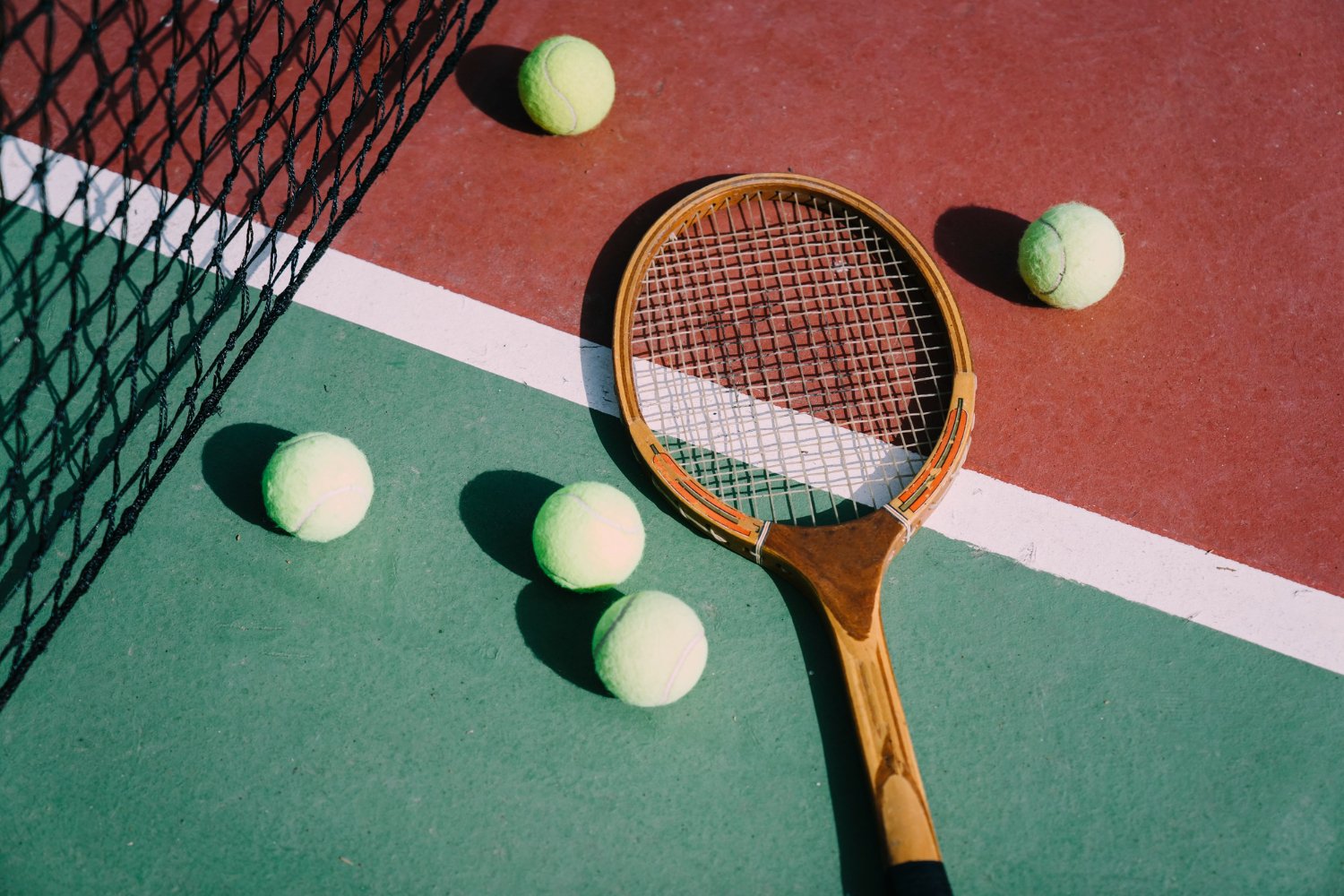Celebrating Tennis History for National Tennis Month
May is National Tennis Month, which means it’s time to dust off your racquet, channel your inner Serena or Federer, and crack open the history books! Okay, we admit history books aren’t usually part of a game of tennis, but this week we’re exploring the fascinating history of this magical sport! Spoiler: it involves French monks, royal courts, and a guy named Major Wingfield. Tennis has a wild and interesting history that spans centuries, continents, and fashion trends (including tennis corsets…no, thank you).
So, in honor of National Tennis Month, let’s serve up a quick history lesson that will make you appreciate your next match a little more and give you some trivia to drop on the court.
The Origins of Tennis
The earliest version of tennis dates all the way back to 12th-century France, where monks invented a handball game called jeu de paume, or “game of the palm.” That’s right — no racquets, just bare hands and divine ambition.
Over time, players realized that slapping a ball around a monastery wasn’t very comfortable, so they started using gloves, then paddles, and eventually primitive racquets. By the 16th century, this evolved into real tennis, also known as “royal tennis” because it was basically the go-to hobby for kings. Think of it as the OG country club sport, complete with confusing rules and a dress code you wouldn’t survive in today’s heat.
One of the most famous fans? King Henry VIII, who reportedly built his own tennis court at Hampton Court Palace. (Say what you will about the guy’s dating history — he had excellent taste in sports.)
The early game looked a bit different than what we play today, but the seed was planted. The idea of hitting a ball back and forth for fun, glory, and community bonding? Timeless.
The Birth of Modern Tennis
Fast forward to the 1870s, when lawn parties were all the rage in England and people had finally started asking, “What if we don’t have to have a palace to play tennis?” Enter Major Walter Clopton Wingfield, a man with a spectacular idea: tennis on grass. Wingfield patented a version of the game he called “Sphairistikè.” Thankfully, the name didn’t stick, but the game did.
Then came Wimbledon, the world’s first lawn tennis tournament, which debuted in 1877 on a croquet lawn in London. It was a modest event — just 22 male players and one winner who probably didn’t realize he was making history. The rules were standardized, the game was formalized, and suddenly, tennis wasn’t just for kings and monks anymore. It was for anyone with access to a patch of grass and decent aim.
Thanks to its portability and simple equipment, lawn tennis exploded in popularity. What started as a backyard pastime became a full-fledged sport, complete with clubs, leagues, and Victorian-era spectators judging your backhand in waistcoats and bonnets.
Tennis Goes Global
Once the British got the ball rolling (literally), it didn’t take long for tennis to hop across borders faster than a perfectly executed volley.
By the 1880s, tennis had made its way to the United States, where it quickly found a fanbase among the upper crust who loved a good lawn game almost as much as they loved a good mint julep. In 1881, the U.S. National Lawn Tennis Association (now the USTA) was born, and the first U.S. Open (then called the U.S. National Championships) was served up in Newport, Rhode Island.
Meanwhile, tennis was also gaining ground in Australia, France, and beyond. The sport spread across the globe, planting the seeds for what we now know as the Grand Slam tournaments:
Wimbledon (1877 – England)
U.S. Open (1881 – USA)
French Open (1891 – France)
Australian Open (1905 – Australia)
Suddenly, tennis wasn’t just a quirky British pastime — it was an international obsession. Players began competing on different surfaces—grass, clay, and later, hard courts—each with their own quirks.
As tennis planted its roots around the world, it set the stage for some of the most iconic athletes, matches, and moments in sports history. But before we get there, let’s talk about the trailblazers who turned tennis into a game of progress, not just points.
Breaking Barriers & Making History
By the 20th century, tennis had the look of a proper global sport, but it still had some serious growing up to do. For a long time, the courts weren’t exactly welcoming to everyone. That started to change thanks to some absolute legends who weren’t just hitting balls, but were smashing barriers.
Let’s start with Althea Gibson, who in the 1950s became the first Black player to compete (and win!) at Wimbledon and the U.S. Open. She was powerful, graceful, and tough as nails. Althea didn’t just play the game — she redefined it.
Then came Arthur Ashe, another Black history-maker who won the U.S. Open in 1968, Wimbledon in 1975, and the Australian Open in 1977, and did it all with a cool calm that made opponents sweat. Off the court, he was a fierce advocate for social justice and health equity — basically, a Grand Slam human being.
And let’s not forget Billie Jean King, who didn’t just dominate women’s tennis — she rewrote the playbook. In 1973, she faced off against Bobby Riggs in the legendary “Battle of the Sexes” match and won, BIG time. The match wasn’t just great tennis, it was a mic drop for gender equality in sports.
Tennis also made huge strides in accessibility, with the development of wheelchair tennis in the 1970s. Thanks to innovators like Brad Parks, the sport opened up in powerful new ways, proving that great tennis is about passion and skill, not physical limits.
Tennis in the Modern Era
Welcome to the age of power serves, slow-motion replays, and racquets made of space-age materials. Modern tennis is faster, louder, and sometimes more dramatic than a reality show (but in the best possible way).
Let’s talk tech. Gone are the days of wooden racquets and lacy ankle socks. Today’s players wield light and powerful graphite racquets, specially designed for optimal performance on the court. Then there’s the data. Players now use analytics, wearable trackers, and video analysis to fine-tune their game.
And of course, we can't talk about the modern era without bowing down to the GOAT contenders:
Serena Williams, whose dominance, style, and “don’t-mess-with-me” stare redefined the game
Roger Federer, the Swiss maestro with a backhand smoother than jazz
Rafael Nadal, the king of clay and general destroyer of tennis balls
Novak Djokovic, a relentless machine of flexibility and focus
These superstars—and so many others—have made tennis a global spectacle. But even as the sport reaches new heights on the world stage, it’s stayed remarkably grounded. Tennis still thrives at the community level, where beginners, weekend warriors, and future stars all pick up a racquet and fall in love with the game.
And speaking of love (and we mean that in the tennis and emotional sense)...
Tennis at Western Racquet & Fitness Club
Here at Western, we like to think we’re part of the continuing legacy of tennis. Whether you’re chasing your first rally, fine-tuning your topspin, or just here for the post-match smoothies, there’s a place for everyone on the Western courts.
If you’re interested in learning more about tennis at Western—like leagues, lessons, beginners classes, junior tennis, drills, mixers, and more—check out our tennis webpage or email tennis director Jayson Memken at jayson.memken@westernracquet.com with your questions!
Tennis has come a long way from royal courts and leather balls, but one thing hasn’t changed — it brings people together. And that’s exactly what we love most about it.


